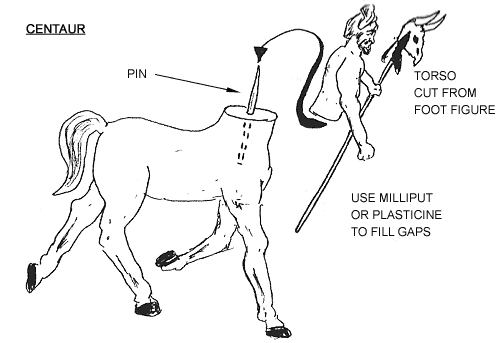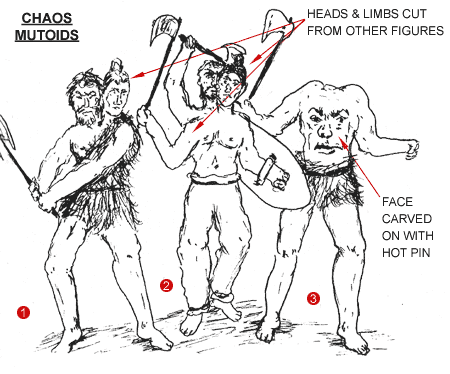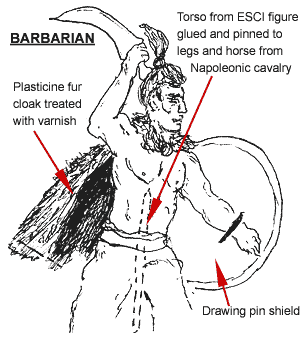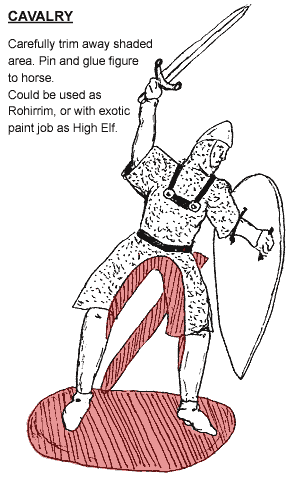
Issue: 3
Metamorphosis
Creating new fantasy figures from plastic
by John Taylor Koziol
This could be regarded as a follow up article to Steve Blease's "Fantasy Battle on a Budget" in issue one. In that article Steve listed the variety of soft plastic figures on the market and gave some ideas for their use.
One of the great advantages that these figures have is their adaptability. Older gamers will probably remember when innumerable articles in Airfix Magazine, Slingshot and other publications detailed how to convert Airfix figures into fighting men from virtually any milieu. As metal figures became more available, the need to do so diminished.
As a result, many younger gamers might not at first realise the possibilities these figures have and the techniques used to convert them.
A real snobbery has grown up around metal figures. I have to admit that, like most people, I would rather use them, but as Steve notes in issue one, many of these figures are pricing themselves out of reach, at a time when most of us are getting more and more strapped for cash.
Also, despite their best efforts, the figure manufacturers cannot provide us with every figure we need. Fantasy gaming should not be about imagination, we should not be afraid of developing our own races and game settings; if necessary creating the figures we need.
Not only do plastic figures give us the chance to build up large armies for a fraction of the cost in even 15mm metal, they also give us the chance to develop our own modelling skills. Many of the people who used to 'chop' metal figures went on to become figure designers. I feel it is one reason there are a lot if indifferently painted armies about, gamers can not afford to 'mess about' with figures and learn new modelling skills in the process.
Tools and Modelling Materials:
You will need the following:
- A sharp knife, preferably with replaceable blades. Use a heavy curved blade for chopping figures in half, removing limbs etc. A narrower, slimmer blade is needed for fine trimming and carving. I use a scalpel and several packs of blades bought from an art shop. You should also have something suitable to cut on, a piece of hardboard or a strong floor tile will do. Remember to always cut away from yourself. My fingertips used to be perpetually scarred from not doing this.
- A strong pair of pliers or similar which can cut pins and lengths of wire, and can be used to shove these into figures, I have two old scissor-style nail clippers, rescued from the bin, which have seen years of service.
- A long pin, needle or length of wire fixed into a suitable handle (balsa will do). This is heated up in a candle or gas flame (need I tell you to be careful again?) in order to weld plastic together, alter the way limbs bend and even recarve faces.
- Evostick adhesive - this is still just about the best glue for this type of figure. Because these figures are flexible, Superglue tends to spring off when they are handled. You might find it quite hard to buy though, glue sniffers have made many retailers reluctant to stock it.
- Plasticine and/or Milliput: Plasticine can be 'set' by applying nail varnish, banana oil or polystyrene cement to it. Lumps of it can also serve as a vice cum 'helping hand' when trying to manipulate fiddly bits.
- Pins - brittle steel ones are best for cutting and pinning figures together. More malleable iron or brass ones can be beaten into shape for spears, swords and even axes.
The following conversions should give you ideas of your own. Remember, you are entitles to your own opinions of what a particular race or troop type looks like!
Centaurs:
These could be built up into an army in their own right, or be part of a Grecian fantasy force or Chaos horde. They are very simple to make.
The torsos come from bare chested Esci 'Barbarians'. Those using a two handed axe could have a lump of Milliput or treated Plasticine put on the axe handle to convert it into a club.
Cut the head and most of the neck of a suitable plastic horse, remembering to trim all the detail of the harness, saddle cloth etc. Make sure that the width of the neck matches up reasonably well with the diameter of the torso you are using. I actually used a lot of old Airfix horses I had knocking about, but others come from Esci's French Cuirassiers or British Hussars sets. I think these yield more than a dozen horses per pack.

Chaos Mutants:
Many fantasy settings call for warped humanoids who have sprouted extra heads, limbs, degenerated into bestiality or found other ways to stand out in the public bar.
These figures might also serve the SF gamer as mutant denizens of a radioactive waste (who have of course, regressed technologically - bows and arrows against lasers?). Some conversions could even be used to advantage with smaller scale metal figures as the more peculiar Giants and Titans or Greek, Norse and Mediaeval legend.

Figure no.1 is converted from an Esci's Barbarian axeman. A head cut from another figure is pinned and glued or heat-welded into place. Figure no. 2 is another variants, with an extra arm added.
Figure no. 3 could actually be used as another fantasy race in the traditions of Classical/Mediaeval myth, where tales of headless men occur. He was used as a donor for a head transplant, new facial details being carved on his chest with a hot pin.
Other creations include 'dog-faced' men made by using a hot pin to texture hair onto face and body. Figures with animal heads (remember those horse heads that you cut off to make the centaurs?). I am sure you will think of plenty of others (even down to simply melting faces into horrible masks).
Trolls and Orcs:
These are really variants on the above (Trolls can have extra heads etc). A hot pin or other texturing device can be used to add scales to the figure's skin. I used to have a U shaped tool that came from a very cheap wood carving set that was ideal for this purpose.
It is also fairly simple to "uglify" facial features with a hot pin to create orcish features. The Revell Saxons and Normans provide armoured figures which are good for Uruk-Hai and Man-Orcs. The not inappropriate fashions that has developed for showing Orcs in 'German' style helmets can be exploited by actually using WW2 figures with most uniform details removed and plastic weapons replaced with wire pins for spears etc. Use a hot pin to mottle up chain mail. Those fine upstanding Teutonic figures can be bent into distortion by dipping them into boiling water, bending them and putting them under the cold tap to fix them.
Other tips:
When using the Esci figures and others to produce a barbarian horde, swap torsos, legs and heads to create maximum variation. Cloaks can be added from Milliput or Plasticine or tissue paper set with varnish/cement. Texture hair and fur garments with the hot pin to create shaggier, more 'barbaric' look.

To create cavalry, use a suitable torso twinned with the legs from a similar rider. Trim off any inappropriate detail. You may have to add tunic skirts etc, to finish the figure off, using either Plasticine or Milliput. Further Plasticine or paper detail can change the horses harness or saddlery to something more appropriately ornate or archaic.
By the way, the Revell Norman with his legs apart swinging his sword, needs only a minimal amount of trimming to make him sit astride a horse (see illustration). Try mixing some blue or green in with silver paint to give his armour a more ornate, exotic look - especially good for elves.

With all flexible plastic figures, it is necessary to glue, pin and weld parts together as securely as possible. If using horses with separate bases, such as Airfix used to make, use a length of pin to connect and brace horse and base, painted black the pin does not show up too badly. With due care, these plastic figures then stand up to campaigning as well as their metallic brethren.
See also:
- Previous article: Research and Respectability
- Next article: Back To Reality
- Index of all articles in Ragnarok 3
- Index of all articles by John Taylor Koziol
- Modelling and Painting > Figures